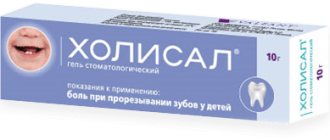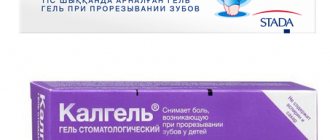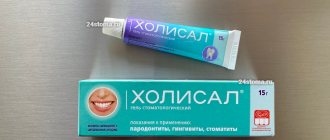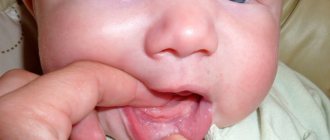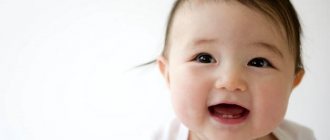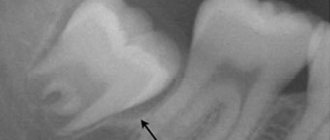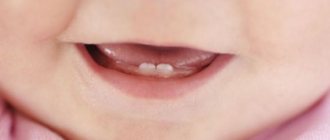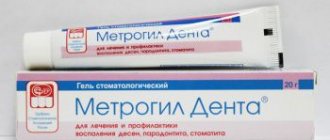Gum inflammation is accompanied by a number of painful symptoms that not only affect your well-being, but also affect your ability to chew and speak normally. To eliminate unpleasant signs in dentistry, special gels are used. They act directly on the oral mucosa and are slightly absorbed into the blood, which makes them safe for children.
Painkillers and anti-inflammatory gels can be used during teething (Baby Doctor) and for complex treatment of gingivitis or stomatitis.
Indications for use of dental gels
The dentist may prescribe the gel to a child or adult when there are signs of gum inflammation. The reason for using the gel will also be stomatitis, which affects not only the gums, but also the entire oral mucosa.
Dental gel will help with the following symptoms and diseases:
- pain, burning, redness along the edge of the tooth crown;
- bleeding gums after chewing hard foods and brushing teeth;
- thrush, fungal stomatitis or oral candidiasis;
- glossitis (inflammation of the tongue) and papillitis (inflammation of the dental papilla);
- teething in a child;
- growth of wisdom teeth, which is accompanied by gum damage.
The medicine can only be used topically. The gel is applied to the affected areas of the mucous membrane up to 4 times a day, according to the instructions. After treating the gums, it is recommended not to eat anything for several hours, and not to drink for at least half an hour, so as not to wash off the drug. Before applying, be sure to rinse your mouth with an antiseptic or regular mouthwash.
Some types of gels are homeopathic remedies, therefore, in case of severe inflammation and pain they will be ineffective (Malavit), others have a strong anti-inflammatory and analgesic effect. There is a large selection of dental gels; it is important to understand how they differ, and which one is better for a particular problem.
A few facts about teething
- ideally, when the first milk teeth appear at 6 months: but if their eruption is delayed by a couple of months, i.e. falls at eight months of age, then there is no need to worry either - this situation is within normal limits. There is also no need to worry when the first milk units appear a little earlier, for example, at 4-5 months,
- If the baby is 10 or more months old, and the first teeth are not pleasing with their appearance, then it’s time to see a dentist, because this may indicate a violation of the formation of the jaw system,
- In most cases, the central incisors appear first on the lower jaw, then their antagonists erupt on the upper jaw. Afterwards, the lateral incisors delight with their appearance, then the fangs, which are also called “eye” ones. If the order is broken, then there is no need to panic, because... This process can be individual for each person. But it is still necessary to pay close attention to this point. For peace of mind, visit your dentist.
The photo shows the timing of the eruption of baby teeth.
Read the article on the topic: the main causes of cough and snot during teething.
Which gel is better?
A well-known representative is Dental. This is an anti-inflammatory gel; it contains corn oil, which promotes the formation of a protective barrier on the mucous membrane, which allows damaged cells to recover faster and prevent complications.
It is recommended to use Dental up to 4 times a day, applying it in a thin layer to the entire surface of the inflamed gum. This drug will also help those who are faced with denture stomatitis. The drug accelerates regeneration, reduces inflammation and relieves pain.
Parodium is another good remedy for inflammatory diseases of the oral mucosa. It is both an antiseptic and has an anti-inflammatory and hemostatic effect. Indicated for the treatment of periodontitis, gingivitis, traumatic and bacterial stomatitis.
Kalgel and Baby Doctor are one of the safest products for children during teething. They relieve pain, cool the gums, and begin to act almost instantly. Their only drawback is the short duration of pain relief; they can relieve unpleasant symptoms for up to 30 minutes.
The most well-known representatives, which are most often recommended by dentists, are the gels Metrogyl Denta, Asepta, Cholisal, Solcoseryl and Kamistad.
Cholisal's analogs
Many buyers are looking for something to replace Cholisal with. This is not surprising, because the average cost is 400 rubles.
List of cheap analogues of Cholisal with prices.
| Analogue | Price in rubles | Manufacturer country |
| Holisal | 350-400 | Austria |
| Candide | 300-500 | India |
| Dentamet | 110-180 | Russia |
| Anti-Angin Formula | 350-400 | Netherlands |
| Dantinorm | 1000 | France |
| Metrogil Denta | 250-300 | India |
| Kamistad | 250-350 | Germany |
| Stomatophyte | 220-280 | Poland |
| Solcoseryl | 380-450 | Switzerland |
| Faringosept | 180-230 | Romania |
| Asepta | 160-300 | Russia |
| Dentinox | 380-420 | Germany |
| Dantinorm Baby | 1000 | France |
| Leader Baby | 230-280 | Russia |
| Kalgel | 450-500 | Poland |
The most popular children's dental analogs of Cholisal gel include such products as Kamistad, Metrogyl Denta, Kalgel, Solcoseryl, Asepta. Let's take a closer look at the listed medications.
Metrogil Denta
Contains an antibacterial substance - metronidazole and an antiseptic - chlorhexidine. It is used to relieve gum pain during stomatitis, after dental treatment, during an inflammatory process due to infection or traumatic injury.
The gel is practically not absorbed, therefore it is safe for treating the oral mucosa of a child. But at the same time, the low concentration of the active ingredient makes it not the most effective against severe inflammation; after treatment, there may be a relapse.
Properties and composition
Dental gel is a homogeneous transparent mass to which no dyes are added. The basis of the solution is oil produced from anise seeds, which gives the product a certain specific smell.
The composition includes several active components, namely:
- citalkonium chloride, which is an effective antiseptic substance that can have a detrimental effect not only on pathogenic bacteria and fungal microorganisms, but also on viruses;
- choline salicylate, capable of penetrating into tissues, providing not only an antipyretic, analgesic and anti-inflammatory effect, but destroying both fungal life forms and microbes, stopping the activity of microorganisms living in acidic and alkaline environments,
allowed pharmacists to create a drug that promotes the complex treatment of common dental diseases.
Solcoseryl
One of the most popular gels in dentistry is Solcoseryl. This remedy is classified as a medicine (while many others act as balms), therefore it is recommended by dentists for the treatment of such unpleasant pathologies as oral candidiasis, viral, traumatic and necrotizing ulcerative stomatitis.
Solcoseryl gel will help get rid of pain; the active ingredients in its composition stimulate metabolic processes in the affected tissues, which accelerates regeneration.
Possible problems when using the drug
Dentists say that the product does not always have a positive effect. Some people may have an allergic reaction to Cholisal gel. In this case, analogues are selected with an alternative composition, and treatment continues.
Dentists also note that the anise oil included in the drug can cause excessive salivation. If for an adult this does not present any discomfort, then with small children everything is different. So, babies in the first year of life do not yet swallow all the saliva that comes out. In this case, liquid flows out of the mouth and irritates the skin. Dentists also say that children can choke on saliva. Most often, this problem occurs in babies in the first six months of life.
That is why the drug is prescribed for children with extreme caution and only in some cases.
If you use the drug incorrectly, complications may occur. The most common violation is neglect of sterility. So, applying medicine with dirty hands can cause an infection. In this case, dentists say that the patient not only does not experience relief, but also develops an infection. In this case, the person additionally needs antimicrobial therapy.
Disadvantages of the medication
No matter how effective this drug is, it has certain disadvantages. For example, for a tube of small volume you will have to pay a relatively large amount. In addition, among its disadvantages:
- Pronounced aroma and taste of anise. Due to this, salivation often becomes abundant, and the mucous membranes of the oral cavity become irritated.
- Presence of contraindications.
- Possible side effects.
No other shortcomings have been identified in Kholisal. It has proven itself to be an effective and efficient drug. Most often it is well tolerated.
special instructions
The drug is intended exclusively for topical use. It cannot be taken orally. The medicine does not affect the ability to operate machinery or drive vehicles. There is also no limitation of physical activity.
For long-term and short-term treatment, it is not recommended to use Cholisal simultaneously with other antibacterial agents. The medication combines well with other drugs. No obvious incompatibility was identified.
If the permissible dosage is increased excessively, Cholisal can enhance the effect of other painkillers, antipyretic and anti-inflammatory drugs.
If the recommended dose is observed, such an effect is not observed.
The gel cannot be frozen or stored in the refrigerator.
The optimal storage temperature is 25 °C. The medicine should be kept out of the reach of children. The shelf life of the medicine is 3 years. After opening the tube, the gel is stored for no more than 2 weeks. The duration of continuous therapy should not exceed 10 days.
Possible unwanted effects
The instructions prescribe using the drug with caution during pregnancy and breastfeeding, that is, the product must be recommended by a specialist, which involves monitoring its use and abandoning the gel, if necessary.
Thus, domestic medicine does not prescribe treatment with Cholisal gel during the first trimester of pregnancy.
Complications and negative consequences when using Cholisal gel were observed by practicing doctors extremely rarely. However, increased individual sensitivity to the ingredients of the drug can manifest itself as:
- not a strong burning sensation in the areas where the product was applied;
- redness;
- itching
These side effects most often disappear within a few minutes.
However, when the first unwanted symptoms appear, experts recommend stopping using the gel, since the cause of an allergic reaction may be:
- salicylates;
- anise oil,
as well as other ingredients included in the product.
In addition, dentists advise using the optimal amount of the drug during procedures, avoiding overdose.
In addition, it should be taken into account that the use of cholisal with other analgesics, anti-inflammatory drugs, antipyretic syrups can increase the concentration of active substances in the body, and an excess of antibiotics and antiseptics can also cause an allergic reaction.
Considering the free sale of Cholisal gel in pharmacies, before purchasing and using the drug, you should consult with a specialist, which will allow you to use the modern combined action product most effectively.
